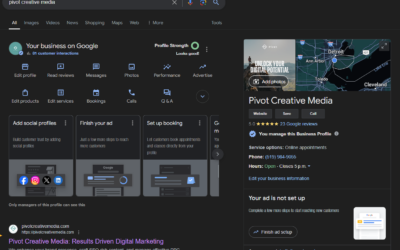Understanding Meta Descriptions
Meta descriptions are crucial for attracting users to your website through search engine results pages (SERPs). They can impact click-through rates and indirectly affect your SEO rankings.
Role in SEO and SERPs
Meta descriptions serve as a short summary that gives users a reason to click on your page from the search results. While search engines like Google may rewrite them, a well-crafted meta description can still make a significant difference.
Search engines use meta descriptions to understand a page’s content better. A clear and relevant meta description helps search engines match the page with the search query. This improves your visibility in search results.
Effective meta descriptions can lead to higher click-through rates (CTR). Higher CTRs are essential for better SEO performance. The more users click on your page, the more likely it will rank higher over time.
Visibility and attractiveness in search results are also enhanced by good meta descriptions. They act as an ad for your page, convincing users that your content is the best match for their query.
Meta Description Fundamentals
A meta description is usually a short text snippet, up to 155 characters long. It appears below the title tag and URL in the search results. This brief summary should be compelling and relevant to the page’s content.
Good meta descriptions are straightforward and to the point. They often include the focus keyword or phrase that matches search queries. Properly including these keywords helps search engines and users understand your page’s relevance.
Use action-oriented language to encourage clicks. Words like “learn,” “discover,” or “find out” can make your description more engaging. Always aim to match user intent by addressing potential questions or needs directly.
Remember, even though Google might rewrite your meta description, creating a strong, keyword-rich description maximizes your chances of standing out in search results.
Creating Effective Meta Descriptions
A good meta description is unique, boosts click-through rates (CTR), and avoids getting cut off. Here’s how to craft one that stands out and performs well.
Crafting a Unique Description
A unique meta description sets your webpage apart. Avoid duplicating descriptions across pages. Each description should be specific to its page content.
Use an active voice to make it engaging. For instance, say “Discover our summer collection” instead of “Our summer collection is available.” Including your focus keyword helps searchers understand the relevance to their query.
Make sure the description matches the content on the page. Misleading descriptions can harm your reputation and reduce clicks over time. Keep it concise yet informative, providing just enough detail to intrigue users.
Optimizing for Click-Through Rates
To boost CTR, your meta description should be actionable. Phrases like “Learn more,” “Sign up today,” or “Find out how” encourage users to click.
Include a call to action (CTA). This drives user engagement. Mix CTAs with benefits that appeal to your target audience. For example, “Save 20% on your first order” gives a clear incentive.
Showcase what’s unique or valuable about your page. Highlight awards, unique features, or key benefits. This not only attracts attention but assures users of the value on your page.
Length and Truncation Considerations
Meta descriptions should be around 155 characters. Anything longer might get cut off in search results, leading to incomplete information. Shorter descriptions risk missing key details.
Focus on the main point early in the description. Front-load important information so that even if it’s truncated, key details are visible.
Use crisp and clear language to convey your message efficiently. Avoid redundancy and filler words. Every character counts, so make sure each word adds value to your description.
Keeping these tips in mind will help you create effective meta descriptions that engage users and improve your page’s performance in search results.
Technical Aspects of Meta Descriptions
When creating meta descriptions, you need to know about their HTML structure, how to place them, character limitations, and pixel considerations for different devices.
HTML Structure and Placement
Meta descriptions are placed in the <head> section of an HTML document. Use the <meta> tag with the attribute name="description". The content of the meta description should provide a clear idea of what the page is about.
<head>
<meta name="description" content="This is a brief summary of the webpage content.">
</head>
Proper placement ensures search engines can read and use it in search results. This is important for search engine optimization (SEO) and can affect your website’s visibility.
Character Limits and Pixels
The length of meta descriptions is measured in characters and pixels. For most search engines, the ideal length is between 150-160 characters to avoid truncation.
| Device Type | Character Limit | Pixel Limit |
|---|---|---|
| Desktop | 150-160 | 920 pixels |
| Mobile | 120 | 680 pixels |
Using the right length and ensuring it fits within pixel limits ensures your meta description displays properly across different devices, like laptops and mobile phones. Choose concise and relevant wording for the best results.
Strategies for Different Page Types
Meta descriptions need to match the page type to effectively draw users in and improve search engine rankings. You should tailor your meta descriptions to fit the search intent and search query of the users to boost engagement.
Product and Category Pages
For product pages, focus on the unique features and benefits of the product. Highlight specific details that set the product apart, such as special features or uses. Use clear and precise language.
- Example for Product Page: “Discover the latest tech with Apple’s new iPhone. Features include a groundbreaking camera, powerful processor, and long battery life.“
With category pages, emphasize the range of products available and the unique advantages of shopping from this collection. Make it inviting for customers to browse.
- Example for Category Page: “Explore our wide selection of high-quality coffee beans. From single-origin to blended varieties, find the perfect coffee for your taste.“
Homepages and Landing Pages
For homepages, aim to give a clear and enticing overview of what your site offers. Emphasize broader themes and major categories to attract a wide audience.
- Example for Homepage: “Welcome to TechWorld – Your destination for the latest in tech news, reviews, and products.“
Landing pages should focus on specific campaigns or products where search intent is crystal clear. Use action-oriented language to boost conversions and provide clear calls to action.
- Example for Landing Page: “Join our exclusive webinar on digital marketing strategies. Learn from experts and increase your business’s online presence.“
Tools and Plugins for Meta Description Optimization
For optimizing meta descriptions, using the right tools and plugins can make a huge difference. These tools help ensure your meta descriptions are efficient and drive more clicks.
SEO Tools and Analytics
Yoast SEO: This popular plugin for WordPress helps you easily create and optimize meta descriptions. It also provides instant feedback on readability and SEO factors.
SEO Plugins: Tools like All in One SEO Pack also offer robust features for creating and managing meta descriptions, making it easier to keep your content optimized.
Google Search Console: Useful for tracking how your meta descriptions are performing in search engine results. It provides insights into click-through rates and can help you identify pages that need better meta descriptions.
Frase: This tool can generate multiple meta description suggestions based on your content and keywords. It’s particularly useful for bulk content creation, speeding up the optimization process.
CMS and Website Builders
WordPress: Aside from standalone plugins like Yoast SEO, WordPress itself offers built-in options to edit meta descriptions. This makes it seamless to integrate into your existing workflow.
Shopify: For e-commerce websites, Shopify provides an easy-to-use interface to add and customize meta descriptions for your product pages, ensuring they are appealing to potential customers.
Wix: Another website builder that offers straightforward tools to optimize meta descriptions. Its intuitive design lets you add keywords and craft descriptions without needing advanced technical knowledge.
Squarespace: This platform also has features to edit and optimize your meta descriptions. They focus on a clean, user-friendly interface, helping you manage SEO tasks efficiently.
Best Practices and Examples
Crafting a good meta description involves combining precise language with an understanding of what searchers are looking for. When done right, it can increase click-through rates and improve your page’s visibility. Below are some tips and examples to guide you.
Writing Tips and Style
Use active voice. This makes your meta descriptions more engaging and direct. Instead of saying “The product can be bought online,” say “Buy the product online.”
Keep it concise. Meta descriptions should remain within 155 characters, so be sure to get your point across quickly. Include keywords naturally, as this can help with on-page SEO.
Focus on benefits. Show the reader how your content or products can help them. For example, “Discover easy recipes to save time in the kitchen.”
Avoid duplicate meta descriptions. Each page on your website should have a unique meta description tailored to the content on that page.
Analyzing Good Examples
GQ: “The GQ example fuses legacy (since 1957), competency (award-winning writing), and practical benefits (look sharper and live smarter) into one compact, effective meta description.” This works because it is specific and connects with the audience.
Moz: “Meta descriptions provide a summary of a webpage’s content, visible in search engine results. Learn effective techniques for crafting compelling descriptions.”
ThemeIsle: This meta description effectively highlights practical benefits: “Look sharper and live smarter.” It combines a catchy phrase with clear benefits to attract clicks.
By looking at these examples, you can see the importance of clarity, relevancy, and brevity. Use these best practices and tailor each meta description to align with what your target audience values and seeks.
Understanding Search Engines and User Behaviour
Search engines rely on complex algorithms and frequent updates to help users find the most relevant content. Your meta descriptions must align with search intent and fulfil user expectations to perform well.
The Role of Algorithms and Updates
Search engines like Google use algorithms to organize and present search results. These algorithms consider numerous factors such as relevance, quality, and user engagement. Google frequently updates its algorithms to improve user experience and deliver the best possible results.
One key element is keywords. They help search engines understand your content’s focus. However, algorithms are sophisticated enough to understand context and user intent beyond just keywords.
Experts like John Mueller emphasize the importance of keeping your meta descriptions relevant and up-to-date. An effective meta description helps ensure your page appears organically in search results, providing a summary that encourages clicks.
Search Intent and User Expectations
Understanding search intent is crucial for creating effective meta descriptions. Search intent refers to the reason behind a user’s search query. When you know what users are looking for, you can tailor your meta descriptions to meet their needs.
For example, if users are searching for “best running shoes,” they likely expect a list of top-rated products. If they search for “how to tie a tie,” a descriptive step-by-step guide would be more appropriate.
User expectations also play a significant role. A clear and concise meta description that accurately reflects your page content enhances user experience. Meeting user expectations increases click-through rates and reduces bounce rates, making your page more appealing to both users and search engines.
To sum it up, aligning your meta descriptions with search algorithms and users’ needs helps improve your webpage’s visibility and engagement.
Impact on Social Media and Sharing
Meta descriptions play a crucial role in how your content is presented and perceived on various social media platforms. They can directly influence the visibility of your shared pages and lead to increased engagement.
Meta Descriptions and Social Platforms
When shared on social media, your meta descriptions often become the default snippet shown below the post title. This snippet helps users decide whether they want to click and view the content.
Different platforms handle these snippets in their own ways. Facebook and LinkedIn usually display the meta description clearly, while Twitter may show a shorter preview. It’s essential to tailor your descriptions to be engaging across all these platforms, ensuring they are concise and include relevant keywords.
Enhancing Visibility and Shares
Well-crafted meta descriptions can significantly boost the visibility of your posts on social media. They should include dynamic action words and a clear call-to-action to inspire users to share your link. Adding hashtags or mentions can also increase the likelihood of your content being shared.
Examples of effective phrases for social shares:
- “Discover the best tips for creating engaging content!”
- “Check out our latest guide on SEO best practices!”
Using engaging and relevant meta descriptions can not only improve the visibility of your content but also encourage more social sharing and higher user engagement.
Monitoring and Improving Meta Description Performance
Tracking the success of your meta descriptions helps you to make informed adjustments that can boost your click-through rates (CTR) and organic traffic. This involves analyzing data and iteratively updating your descriptions.
Analyzing Click-Through Rates
To start, use tools like Google Search Console to track your page’s click-through rates. This metric shows how often users click on your link after seeing it in search results.
High CTR suggests your meta description is appealing and relevant. Low CTR means it’s time for a change. Focus on pages with significant impressions but low CTRs, as these offer the most potential for improvement.
Use the data to examine which descriptions work well. Look for patterns such as length, use of keywords, and the way the value proposition is presented. Experiment with these elements in other meta descriptions to see if you can replicate success.
Iterative Rewriting and A/B Testing
Once you’ve gathered enough data from your CTR analysis, start rewriting your meta descriptions. Make small adjustments to see how each change affects performance.
Use A/B testing to compare two versions of a meta description. This involves showing different descriptions to different users and measuring which one performs better. Ensure that each version is distinct enough to provide clear insights.
When iterating, focus on making sure your meta descriptions reflect the page content accurately. Test elements like phrase structure, key benefits, and emotional triggers. Regularly revise underperforming descriptions and continue tracking their metrics to ensure improvements.
By consistently analyzing and testing, you can optimize your meta descriptions to enhance your organic CTR, improve rankings, and drive more organic traffic to your site.
Frequently Asked Questions
This section answers common queries about crafting effective meta descriptions to boost your site’s SEO. You’ll learn how to make them impactful, integrate keywords, and more.
How can I create an impactful meta description for SEO purposes?
To create an impactful meta description, focus on summarizing the page content clearly and concisely. Highlight the benefits and unique selling points. Make sure it grabs attention and encourages clicks.
What are some effective examples of meta descriptions?
Effective meta descriptions give a quick summary of the page and include a call to action. For instance: “Discover tips to boost your website’s SEO. Click to learn more!” This example is clear, engaging, and drives action.
What is the recommended character length for an optimal meta description?
The recommended length is 70-155 characters. This range ensures your description is fully displayed in search engine results without being cut off.
How should I integrate keywords within meta descriptions?
Integrate keywords naturally within the meta description. Avoid keyword stuffing. Instead, focus on making the description readable and relevant while including important terms that match search queries.
What are the best practices for writing meta descriptions that improve click-through rates?
To improve click-through rates, write compelling descriptions that address user intent. Use action verbs like “discover,” “learn,” or “find out.” Ensure it aligns with the page content and includes a clear call to action.
Are there tools available to check the quality of a meta description?
Yes, there are several tools you can use. Tools like Yoast SEO and SEMrush provide insights and suggestions to improve your meta descriptions. They check length, keyword usage, and relevance.




